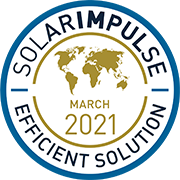News - April 26, 2021
South East Asia’s Labelled Solutions for water cleanup


Written by Allan Gray 5 min read
Here we are, one thousand solutions closer to a cleaner planet. With the #beyond1000solutions campaign, Solar Impulse is gearing up to bring forward the next wave of Cleantech into the world.
To get the ball rolling for the next phase, I’ve put together a short list of some of the solutions getting developed across SE Asia.
The broad categories
To date, SE Asia sits at 16 labelled solutions. I’ve broken them down into 3 broad themes (I guess that makes me a lumper, not a splitter):
Category | Labelled Solutions |
Cleaning up our water | 4 |
Getting more efficient | 7 |
Better, Cleaner Mobility | 5 |
For sure, some will contest my very crude categorizations. I’d encourage them to also write an article.
By Regions
By regions, it’s probably no surprise to anyone that Singapore leads the pack:
Name | Labelled Solutions |
Singapore | 11 |
Hong Kong, SAR | 1 |
Philippines | 1 |
Taiwan | 1 |
Thailand | 1 |
Given the obvious bias that would come along with me trying to pick favourites within a group that our company is active in, I’m only going to talk about my picks from Category 1 & 2. This article is going to be about water.
Disclaimer
I would consider myself as a capable student of pollution solutions in general. However, I claim no expertise or specialized knowledge in any of the technologies mentioned below. I have not reviewed any information beyond what has been made publicly available on Solar Impulse and their own webpage.
Cleaning up our water
There’s no question that global water resources are deteriorating. This decline comes from various factors including:
direct chemical pollution
micro-plastics overtaking fish
fertilizer and erosion runoff killing the world’s coastal ecosystems.
We desperately need to improve our track record on hydro-externalities. The 3 solutions below each endeavour to accomplish that.
EcoWorth is targeting organics in wastewater. Organics are a broad category which include most of the contaminants causing bad smells in most of the region’s urban lakes and waterways.
In the case of this technology, however, the ‘valuable organics’ that they are targeting appear to be some fom of spilled oil.
You may find the video a little hard to understand, but take note of the oily, yellow film on top of the water. Absorbent pillows like these are often used in oil spills on the ocean.
Because of the many pipelines and other oil-producing facilities across the world, these kinds of absorbent materials definitely have widespread demand.
The term for a material that strongly repels water is ‘Cat’. Just kidding, it’s considered a ‘hydrophobic’ material and there are some great video demonstrations like this one out there in the cloud
2. Electro-contaminant removal systemPermalink
ECR targets contaminated wastewater by applying electric fields which cause dissolved contaminants to lump together or coagulate (like your blood, when you get cut). Today, this process is often done using chemicals called floculants.
Avoiding chemical usage with this approach, is certainly attractive and I look forward to seeing more. They are targeting phosphorus, even 10 years ago, concerns were being raised about phosphorus shortages in the coming decades. Now that phosphorus has become a popular battery material, recovering the material from wastewater should be a high priority going forward.
Ocean Plastics is a sector where the Cleaner Production Pyramid plays a hugely important role. The shear volume of plastics entering oceans every day is difficult to fathom. To really make a dent on this issue will require solutions at every level of the pyramid.
Given that collection/recovery, sits so low on the pyramid, they will probably be categorized as among the most expensive solutions. But that doesn’t mean it’s not necessary. When PlakMan’s boats hit the water to start sucking up plastic, I hope careful thought will be given to the location of their initial deployments.
With all that said, I’m very happy to see new groups coming in to join the effort. Humanity has had quite the party since first discovering plastics. The cleanup job is substantial and many hands make lighter work.
Wrap up
Hopefully, some of my thoughts above have been helpful in looking at where we might go with these solutions.
Since you’re here, feel free to look around and learn more about our own solution. You can check out our Solar Impulse profile.
I’m very excited to see these projects continue to build steam as we move #beyond1000solutions.
This article was originally published on: https://www.sunetrike.com/solar-impulse/se-asias-water-cleanup-solutions/

Written by Allan Gray on April 26, 2021








